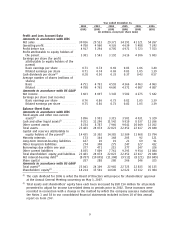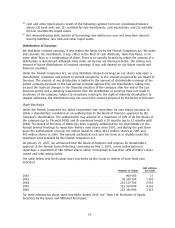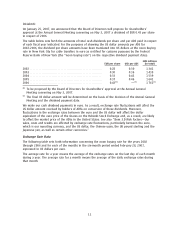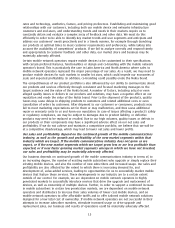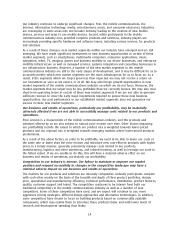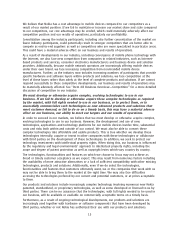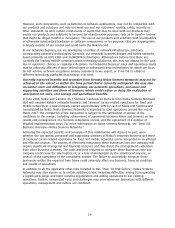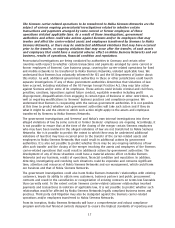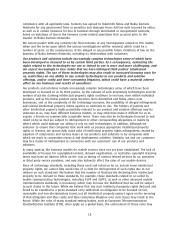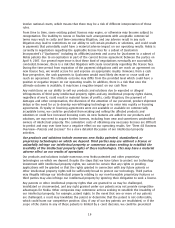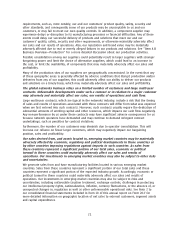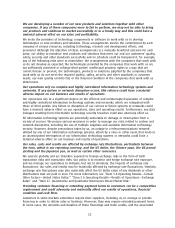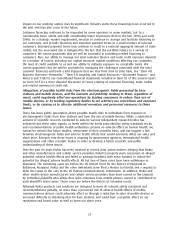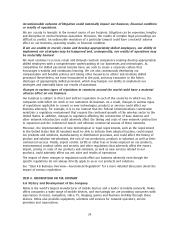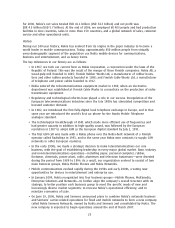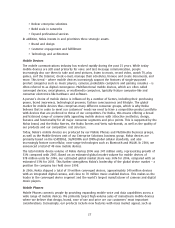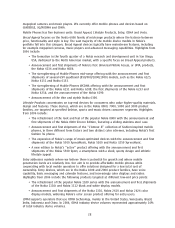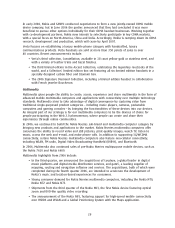Nokia 2006 Annual Report Download - page 20
Download and view the complete annual report
Please find page 20 of the 2006 Nokia annual report below. You can navigate through the pages in the report by either clicking on the pages listed below, or by using the keyword search tool below to find specific information within the annual report.involve national courts, which means that there may be a risk of different interpretation of those
rules.
From time to time, some existing patent licenses may expire, or otherwise may become subject to
renegotiation. The inability to renew or finalize such arrangements with acceptable commercial
terms may result in costly and timeconsuming litigation, and any adverse result in any such
litigation may lead to restrictions on our ability to sell certain products or solutions, and could result
in payments that potentially could have a material adverse impact on our operating results. Nokia is
currently in negotiation regarding the applicable license fees for a subset of Qualcomm
Incorporated’s (‘‘Qualcomm’’ including its affiliates) patents and access for Qualcomm to a subset of
Nokia patents due to an expiration in part of the current license agreement between the parties on
April 9, 2007. Our general experience is that these kind of negotiations eventually are successfully
concluded, however, there is a risk that litigation will create uncertainty regarding the license fees.
During the time period from expiration of the payment obligations until we reach an agreement on
new license fees, we would accrue for and expense an appropriate royalty. However, from a cash
flow perspective, the cash payments to Qualcomm would most likely decrease or cease until we
reach an agreement. The ultimate outcome may differ from the provided level which could have a
positive or negative impact on our operating results. In addition, there is a risk that once the
ultimate outcome is available, it may have a negative impact on our cash flow.
Any restrictions on our ability to sell our products and solutions due to expected or alleged
infringements of third party intellectual property rights and any intellectual property rights claims,
regardless of merit, could result in material losses of profits, costly litigation, the payment of
damages and other compensation, the diversion of the attention of our personnel, product shipment
delays or the need for us to develop noninfringing technology or to enter into royalty or licensing
agreements. If royalty or licensing agreements were not available or available on commercially
acceptable terms, we could be precluded from making and selling the affected products and
solutions or could face increased licensing costs. As new features are added to our products and
solutions, we may need to acquire further licenses, including from new and sometimes unidentified
owners of intellectual property. The cumulative costs of obtaining any necessary licenses are difficult
to predict and may over time have a negative effect on our operating results. See ‘‘Item 4.B Business
Overview—Patents and Licenses’’ for a more detailed discussion of our intellectual property
activities.
Our products and solutions include numerous new Nokia patented, standardized, or
proprietary technologies on which we depend. Third parties may use without a license or
unlawfully infringe our intellectual property or commence actions seeking to establish the
invalidity of the intellectual property rights of these technologies. This may have a material
adverse effect on our results of operations
Our products and solutions include numerous new Nokia patented and other proprietary
technologies on which we depend. Despite the steps that we have taken to protect our technology
investment with intellectual property rights, we cannot be certain that any rights or pending
applications will be granted or that the rights granted in connection with any future patents or
other intellectual property rights will be sufficiently broad to protect our technology. Third parties
may illegally infringe our intellectual property relating to our nonlicensable proprietary features or
third parties may also infringe our intellectual property by ignoring their obligation to seek a license.
Any patents or other intellectual property rights that are granted to us may be challenged,
invalidated or circumvented, and any right granted under our patents may not provide competitive
advantages for Nokia. Other companies may commence actions seeking to establish the invalidity of
our intellectual property, for example, patent rights. In the event that one or more of our patents
are challenged, a court may invalidate the patent or determine that the patent is not enforceable,
which could harm our competitive position. Also, if any of our key patents are invalidated, or if the
scope of the claims in any of these patents is limited by a court decision, we could be prevented
19


